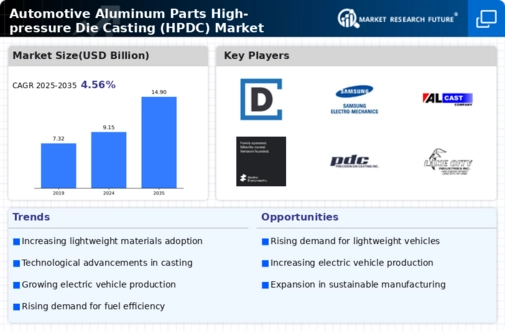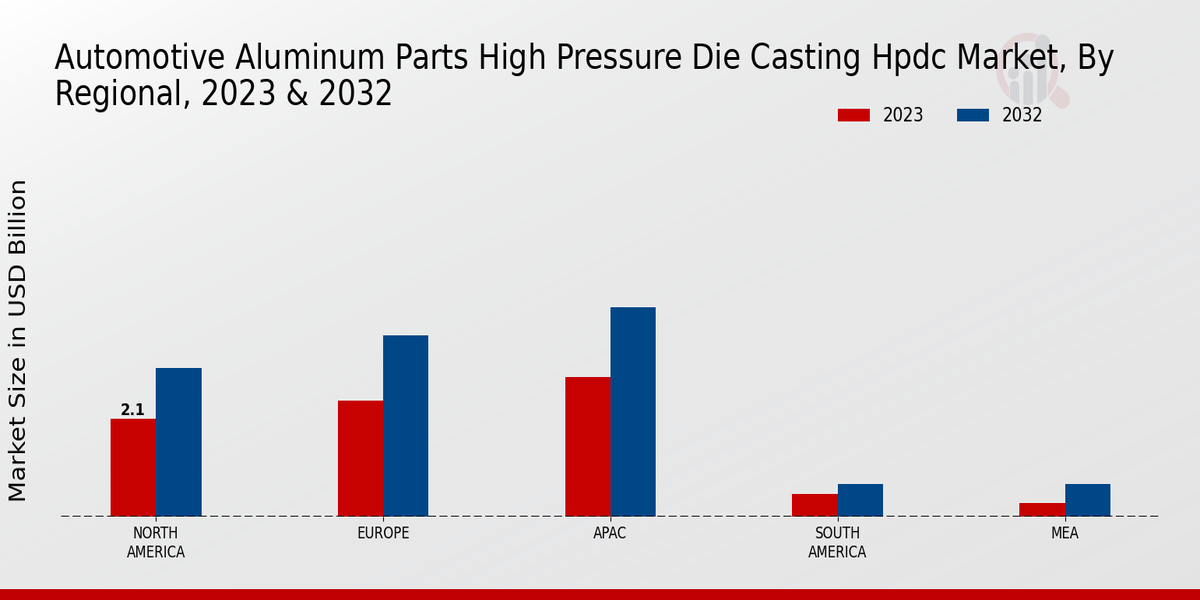Market Growth Projections
The Global Automotive Aluminum Parts High-pressure Die Casting HPDC Market Industry is projected to experience substantial growth over the coming years. With a market value of 9.15 USD Billion in 2024 and an anticipated increase to 14.9 USD Billion by 2035, the industry is on a promising trajectory. This growth is underpinned by a compound annual growth rate of 4.56% from 2025 to 2035, reflecting the increasing adoption of aluminum components in automotive applications. The market dynamics suggest a robust future, driven by technological advancements, regulatory support, and evolving consumer preferences.
Rising Electric Vehicle Production
The rise in electric vehicle production is significantly influencing the Global Automotive Aluminum Parts High-pressure Die Casting HPDC Market Industry. Electric vehicles (EVs) require lightweight materials to optimize battery performance and extend range, making aluminum an ideal choice for various components. As major automotive manufacturers ramp up EV production, the demand for aluminum parts is anticipated to increase substantially. This shift is expected to contribute to the market's growth, with projections indicating a market value of 14.9 USD Billion by 2035. The integration of aluminum HPDC in EV manufacturing aligns with the industry's transition towards sustainable mobility solutions.
Growing Demand for Lightweight Vehicles
The Global Automotive Aluminum Parts High-pressure Die Casting HPDC Market Industry is experiencing a surge in demand for lightweight vehicles, driven by stringent fuel efficiency regulations and consumer preferences for eco-friendly options. Aluminum components, known for their lightweight properties, contribute significantly to reducing vehicle weight, which in turn enhances fuel economy. As manufacturers strive to meet these evolving standards, the market is projected to reach 9.15 USD Billion in 2024, reflecting a robust growth trajectory. This trend is likely to continue as the automotive sector increasingly prioritizes sustainability and efficiency, positioning aluminum HPDC as a critical technology in vehicle design.
Increasing Investment in Automotive R&D
Increasing investment in automotive research and development is driving innovation within the Global Automotive Aluminum Parts High-pressure Die Casting HPDC Market Industry. As companies allocate more resources to develop advanced materials and manufacturing techniques, the demand for high-quality aluminum components is likely to rise. This investment not only enhances product performance but also fosters collaboration between automotive manufacturers and material suppliers, leading to the development of cutting-edge HPDC technologies. Such initiatives are crucial for maintaining competitiveness in a rapidly evolving market, further solidifying the role of aluminum in future automotive applications.
Regulatory Support for Lightweight Materials
Regulatory support for lightweight materials is a significant driver of growth in the Global Automotive Aluminum Parts High-pressure Die Casting HPDC Market Industry. Governments worldwide are implementing policies that encourage the use of lightweight materials to improve fuel efficiency and reduce emissions. These regulations create a favorable environment for the adoption of aluminum HPDC technologies, as manufacturers seek to comply with these standards. As a result, the market is poised for expansion, with the increasing emphasis on sustainability and environmental responsibility shaping the future of automotive design.
Technological Advancements in Casting Processes
Technological advancements in casting processes are playing a pivotal role in the Global Automotive Aluminum Parts High-pressure Die Casting HPDC Market Industry. Innovations such as improved die designs, enhanced cooling techniques, and automation in production lines are increasing the efficiency and quality of aluminum parts. These advancements not only reduce production costs but also enhance the mechanical properties of the cast components, making them more suitable for high-performance applications. As a result, the market is expected to grow at a CAGR of 4.56% from 2025 to 2035, indicating a strong future for HPDC technologies in the automotive sector.





















Leave a Comment